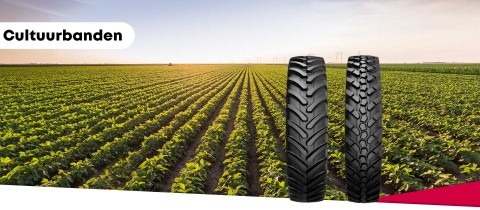Cultivated tyres for agricultural tractors: the basis of an efficient farm business
Standard tractor tires are not always suitable for use on farmland, such as between rows of crops. On these lands, it is important to use cultivated tires to avoid damage to crops. Fortunately, it is possible to convert agricultural tractors on standard tires to cultivated tires, making them usable on these pieces of land.
When it comes to cultivation tires, there are several leading brands. Examples include Michelin, Kleber, Mitas, Alliance and MRL. Each brand has its own unique features and benefits.
Characteristics of cultivation tyres
Below are some of the most common features of cultivated tires:
- Deep grooves: these grooves help reduce wear and provide excellent grip on the land.
- Strong construction: cultivation tires are designed to handle the heavy loads they carry.
- Excellent lateral stability: these tires offer excellent lateral stability, making agricultural tractors more stable and safer to drive.
Advantages of cultivation tyres
Converting from standard tyres to culture tyres is a smart investment that pays off in a short time. Culture tyres have a different profile than regular tractor tires. In addition, using cultivated tyres reduces soil pressure. This reduces land damage and allows you to contribute to a better environment. In the long run, land productivity improves, so you can expect more yields in the future.
- Greater flexibility: with cultivated tires, you can operate your farm tractor on a much wider range of terrains, including roads, forests and other challenging environments.
- Improved performance: because cultural tires are designed to perform in versatile environments, they can give your farm tractor better traction and stability, resulting in better performance and greater efficiency.
- Increased durability: cultural tires tend to be more robust and resistant to wear than tractor tires, which means your investment will last longer and you won't have to spend money replacing them.
- Increased safety: because cultural tires are better equipped to perform in challenging environments, you can have more confidence in your farm tractor and the risk of accidents and damage to your vehicle is reduced.
Technical specifications of cultivation tyres
Culture tyres are available with different technical specifications, depending on the type and brand. Below are some important technical specifications to consider when choosing cultivation tyres:
- Tyre width: tyre width determines how much surface area of the soil is in contact with the tyre, which affects grip and stability.
- Tread depth: tread depth determines the tyre's grip on the land and its protection from compaction and soil degradation.
- Load capacity: tyre load capacity determines how much weight the tyre can support, which is important for the productivity and efficiency of your operations.
Conversion to cultivation tyres
The questions to be asked beforehand are:
- Which agricultural tractor is involved (precise indication of make and type)?
- What tyres are fitted (factory standard)?
- What width should the desired cultivation tyres be?
- What is the desired track width for the agricultural tractor?
Based on this information, we proceed as follows:
- We gather together the technical data of the agricultural tractor (axle width, pitch circle, gear ratio, and so on).
- Then, as a first orientation, we look in the conversion table, if we do not yet know the most suitable tyre combination directly. You can read more about this in our blog on tractor tyre conversion options.
To be 100% sure, that we have chosen the right tire combination, we calculate everything one more time using the formula to calculate the leading edge:
(front tyre rolling circumference x gear ratio ) - rear tyre rolling circumference
Rear tyre rolling circumference x100% = % leading
Maintenance and replacement of cultivated tyres
Maintaining and replacing your cultivated tyres is important for maintaining the performance and longevity of your tyres. Here are some tips for maintaining your cultivation tyres:
- Check pressure regularly: make sure your tires are at the right pressure to ensure optimal performance and reduce wear.
- Inspect tires regularly: regularly check for damage and wear on your tires and replace them if necessary.
- Store tires in a dry place: when not in use, store tires in a dry and safe place to prevent them from being damaged by weather or other factors.
Cultivated tyres and sustainability
Cultivated tyres can contribute to a more sustainable farm by protecting the soil from compaction and soil degradation. This maintains soil productivity and reduces the need for chemicals and other soil improvement tools. The tyres also contribute to an efficient farm, by using less fuel and spending less time repairing damaged soils.
Like to know more?
Please contact us, our experts will be pleased to assist you. Contact our experts at +31 (0)523 - 850 850 or by e-mail to info@heuver.com. You can also read all about agriculture on the agriculture knowledge-page.
Also read our blog Conversion options: from standard tyres to narrow tyres.

